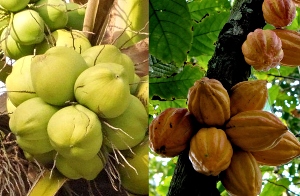 Growing of intercrops in coconut lands produces more food and agricultural products, ensuring food security of the people in rural and urban areas. At the same time, the practice generates jobs and livelihood, enhancing farm incomes and the purchasing power of people, thus alleviating poverty in farming communities (Magat 2004). Moreover, successful farmers serve as inspiration and enterprise leaders in their communities, eventually treating coconut farming in an agribusiness way to create wealth and more capital resources.
Growing of intercrops in coconut lands produces more food and agricultural products, ensuring food security of the people in rural and urban areas. At the same time, the practice generates jobs and livelihood, enhancing farm incomes and the purchasing power of people, thus alleviating poverty in farming communities (Magat 2004). Moreover, successful farmers serve as inspiration and enterprise leaders in their communities, eventually treating coconut farming in an agribusiness way to create wealth and more capital resources.
Cacao (Theobroma cacao L.) is a tree crop that is highly suitable or compatible under different production systems (intercropping or multistory farming, agroforestry, etc). In cacao producing countries, it is grown mainly for its beans, processed into cacao powder, cake and cocoa butter. These products are largely used in the manufacture of chocolates, soaps, cosmetics, shampoo and other pharmaceutical products (PCARRD 2000).
Cacao is also a high value crop wherein the potential is not yet explored in our country with an extensive area suitable for cacao growing as a monocrop or intercrop of coconut. In fact, over 1M ha highly suitable or wet zone of coconut areas (except in coastal areas excessively high in Na or saline soils) are suitable for coconut-cacao intercropping. Its cultivation could promote an agro-industrial development aimed: at value-adding export products, as well as reduction of importation of cacao beans rom countries like Indonesia, Papua New Guinea, and Malaysia (PCARRD 2000). PCARRD mentioned that to date, more than three-fourths of the cacao beans requirement of the country is imported from major producing countries.
Cacao, a popular, stable and marketable long-term beverage crop is widely planted under and between stands of coconut trees. To be a compatible and productive intercrop, cacao tree is best planted not closer than 2 meters from the base of coconut trees, at 3 m between hills and 3 m between rows. Furthermore, where there is limited land for cacao monocropping, the inter-spaces of coconut lands (with 8-15 meters of spacing of coconut palms) are amenable for several rows of cacao crop. Also important, the bio-physical environmental conditions, soil-wise, sunlight-wise and micro-climate variation within the 70-80% space between coconut trees in a farm has been known to be highly suitable for a coconut-cacao ecosystem.
Advantages and Benefits
Coconut trees – produces many basic food products and non-food raw materials for high value products. If there is regular or seasonal demand for tender 8-month old nuts (buko) for tender nut water (buko juice) and tender nut for pies and desserts, the farmers get higher net income compared to the 12-month old mature nuts as buko nuts are usually priced 3-4 times higher than mature nuts. From its inflorescence, coconut sap can be produced which in turn can be processed into high value food products, e.g. coconut sugar, honey, fresh drink and vinegar.
Cacao crop – dried fermented cacao beans (DFCB), the main product of this crop, are first roasted, cracked and grinded to give a powdery mass from which fat is extracted and usually processed into cocoa products such cocoa butter, powder, paste/liquor and chocolate confectioneries. Basically, the chocolate beverage is prepared from cocoa derived from DFCB. The Philippines was the first in Asia to plant cacao and prepare chocolate drinks from cocoa.
Download and Read Full Article Here (This link will open on a new window)
For more information, contact:
FOOD PRODUCT DEVELOPMENT DIVISION
Research and Development Branch
Philippine Coconut Authority
FPDD Plant, PCA Compound., Elliptical Road
Diliman, Quezon City, Philippines
Tel. No.: (02) 8928-4501 to 09
Fax No.: (02) 8926-7631
Email: [email protected]
Website: www.pca.gov.ph
Facebook Page (This link will open on a new window)
Photos: en.wikipedia.org
what program you can offer to those beginner farmer like me, btw I am located in Samar. Hoping for your positive response. Regards.